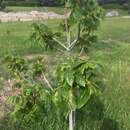Comprehensive Description
(
Inglês
)
fornecido por North American Flora
Zanthoxylum flavum Vahl, Eclog. 3 : 48. 1807
Zanthoxylum cribrosum Spreng. Syst. 1 : 946. 1825.
Zanthoxylum floridanum Nutt. N. Am. Sylva 3 : 14. 1849.
Zanthoxylum caribaeum floridanum A. Gray, Proc. Am. Acad. II. 23: 225. 1888.
Fagara flava Krug & Urban ; Urban, Bot. Jahrb. 21 : 571. 1896.
An unarmed evergreen shrub or tree, sometimes attaining a height of 12 m., with smooth gray bark, the twigs, petioles, rachis, leaflets, and inflorescence minutely stellatecanescent when j-oung, often glabrate at maturity ; leaves odd-pinnate, 1-2.5 dm. long ; leaflets 3-11, commonly 5 or 7, rarely 1, subsessile or short-petioluled, oblong, ovate, lanceolate, elliptic, or elliptic-oblong, 3-10 cm. long, 1.5-5.5 cm. broad, rounded, obtuse, or obtuseacuminate at the apex, rounded, subtruncate, or somewhat acute at the base, crenate or nearly entire, frequently inequilateral, yellowish or grayish-green, the pellucid glands numerous ; petioles and rachis often stout, terete, flattish, or somewhat angled ; panicles terminal, 0.5-1.5 dm. long; staminate flowers : calyx 1-1.4 mm. broad, stellate-canescent ; sepals 5, rarely 4, triangular, acutish, 0.5 mm. long ; petals 5, rarely 4, elliptic-lanceolate or oblong-ovate, 2.5-3.8 mm. long, 1-1.7 mm. broad, greenish-white, reflexed when fully expanded ; stamens 5, rarely 4, about as long as the petals, the filaments slender, the anthers ovate, oval, oroblong-oval ; pistillate flowers: calyx about 1 . 5 mm . broad, stellate-canescent, the sepals triangular, acutish, 0.5 mm. long; petals oblong-ovate, oblong-oval, or ellipticlanceolate, 2.7-3.8 mm. long, 1-1.7 mm. broad, greenish-white, reflexed at maturity ; gynoecium 1-3-carpellary ; style or styles short ; follicles obovoid, brown at maturity, 5-9 mm. long ; seeds obovoid, occasionally globose-obovoid, 4-5 mm. long, 3-4 mm. broad, black, shining.
Type locality : Montserrat.
Distribution : Bermuda ; subtropical Florida ; Bahamas to St. Lucia.
- citação bibliográfica
- John Kunkel Small, Lenda Tracy Hanks, Nathaniel Lord Britton. 1907. GERANIALES, GERANIACEAE, OXALIDACEAE, LINACEAE, ERYTHROXYLACEAE. North American flora. vol 25(1). New York Botanical Garden, New York, NY
Zanthoxylum flavum
(
Inglês
)
fornecido por wikipedia EN
Zanthoxylum flavum is a medium-sized tree in the family Rutaceae. Common names include noyer,[3] West Indian satinwood, yellow sanders, tembetaria, and yellow sandalwood. It is native to Anguilla, Antigua and Barbuda, the Bahamas, Bermuda, Cuba, the Dominican Republic, Guadeloupe, Haiti, Jamaica, Puerto Rico, and the Florida Keys, exclusive of Key West where it has been extirpated.[2] It is threatened by habitat loss and harvesting for its dense, durable wood used in fine woodworking.[4]
Habitat
In its native subtropical range Z. flavum grows in areas with average to high rainfall year-round or with defined dry seasons. It grows on a variety of soils with different drainage regimes, from rapidly draining volcanic derived soils to well-draining clay soils.[1] The tree can grow on serpentine soils.
Description
It grows with a straight bole, producing a limited canopy of pinnately compound leaves,[5] clusters of small pale yellow to cream-coloured flowers and small black seeds. The species epithet flavum is Latin for yellow and indicates its flower colour.[6][7][8] Pollination is probably from bees, and the seeds are thought to be dispersed by birds and bats, as with the closely related species, Z. martinicense.
References
-
^ Hills, R. (2020). "Zanthoxylum flavum". IUCN Red List of Threatened Species. 2020: e.T31861A68084004. doi:10.2305/IUCN.UK.2020-1.RLTS.T31861A68084004.en. Retrieved 15 November 2021.
-
^ a b "Zanthoxylum flavum". Germplasm Resources Information Network (GRIN). Agricultural Research Service (ARS), United States Department of Agriculture (USDA). Retrieved 2009-12-01.
-
^ Austin, Daniel F.; Honychurch, P. Narodny. (2004). Florida ethnobotany : Fairchild Tropical Garden, Coral Gables, Florida Arizona-Sonora Desert Museum, Tucson, Arizona : with more than 500 species illustrated by Penelope N. Honychurch ... [et al. Boca Raton, Florida: CRC Press. ISBN 978-0-8493-2332-4.
-
^ Bucher, Ward.; Madrid, Christine. (1996). Dictionary of Building Preservation. New York: Preservation Press. ISBN 978-0-471-14413-7.
-
^ Britton, Nathaniel Lord. Flora of Bermuda. General Books LLC. ISBN 1-152-54066-1.
-
^ Archibald William Smith A Gardener's Handbook of Plant Names: Their Meanings and Origins, p. 258, at Google Books
-
^ Harrison, Lorraine (2012). RHS Latin for gardeners. United Kingdom: Mitchell Beazley. p. 224. ISBN 9781845337315.
-
^ Sia Morhardt and Emil Morhardt California Desert Flowers: An Introduction to Families, Genera, and Species, p. 101, at Google Books

- licença
- cc-by-sa-3.0
- direitos autorais
- Wikipedia authors and editors
Zanthoxylum flavum: Brief Summary
(
Inglês
)
fornecido por wikipedia EN
Zanthoxylum flavum is a medium-sized tree in the family Rutaceae. Common names include noyer, West Indian satinwood, yellow sanders, tembetaria, and yellow sandalwood. It is native to Anguilla, Antigua and Barbuda, the Bahamas, Bermuda, Cuba, the Dominican Republic, Guadeloupe, Haiti, Jamaica, Puerto Rico, and the Florida Keys, exclusive of Key West where it has been extirpated. It is threatened by habitat loss and harvesting for its dense, durable wood used in fine woodworking.
- licença
- cc-by-sa-3.0
- direitos autorais
- Wikipedia authors and editors

